
Resources
Guitar Resources from Phil Westfall
Many thanks to the geniuses who helped make the charts and diagrams I borrowed from to make many of the actual diagrams and charts you’ll see here.
Some Notes About Notation…
3-PART SONG
You’ve seen that stuff with the funny lines and symbols? That’s called “Standard Notation,” and it’s been around in roughly its present form for about 500 years. Notation is an excellent and precise way to convey virtually any music known to humanity.
Guitarists in the realms of Classical and Jazz have had only notation to read and play from. It’s still the preferred form for these highly skilled and virtuous forms of music.
However, the guitar is very different from almost any instrument encountered in an orchestra or band.
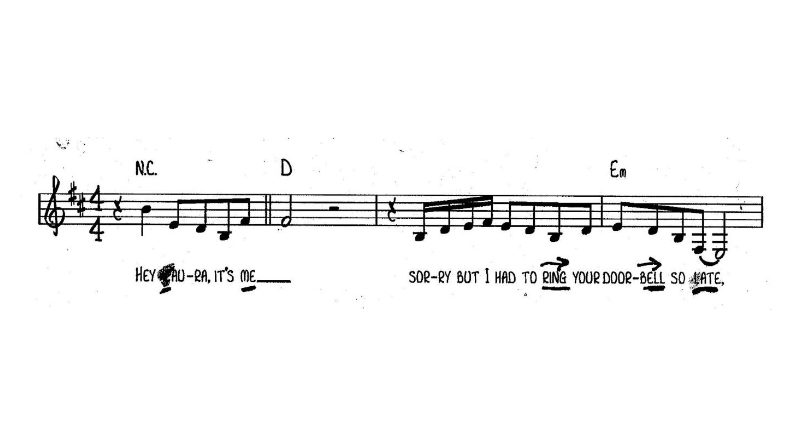
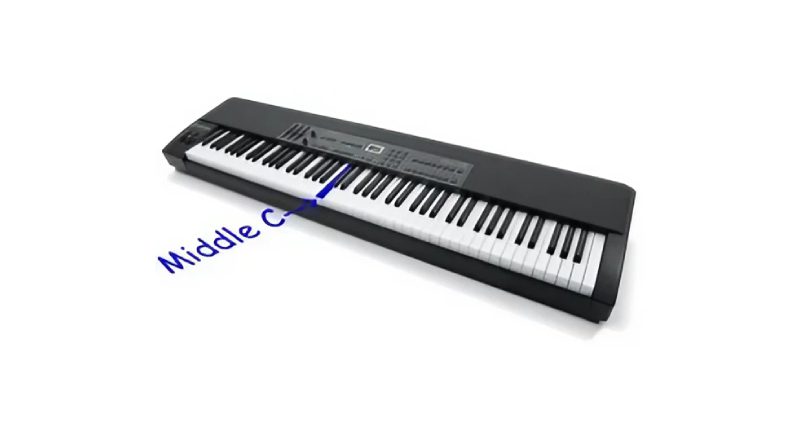
Limitations of Note Reproduction on Musical Instruments
Why? Because on horns, woodwinds, and even pianos, any given note occurs in only one—and I do mean one—place on that instrument. Even the piano, with 88 keys spanning over seven octaves, has Middle C, for instance, on only one key. And one horn can’t play chords.
Uniqueness of Note Placement
On the other hand, Middle C can be found on a Standard-Tuned GUITAR in five places. Here’s the proof:
Folk musicians and those blues cats back in the 1900’s recognized this fact, and said “the heck with these notation charts” (or whatever equivalent words blues cats used back then) and started focusing more on the FORMS that they found sitting all over the guitar. Many of them played strictly by ear, and quite a few didn’t even name notes.
They made stuff up as they went along. They forged the rebar and laid the foundations of practically all popular modern guitar music.
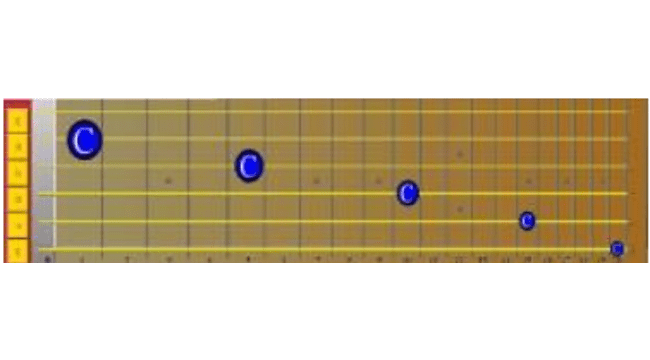
Methods
Phil Westfall’s methods for teaching how to play:
When I began giving guitar lessons back in the late 1980s, the first thing I noticed was that the teaching of Standard Notation predominated. It works, but many players are discouraged by the tedium of learning the guitar one note at a time.
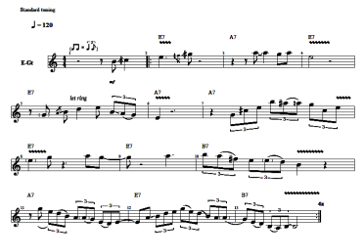
Blues in E - Standard Notation
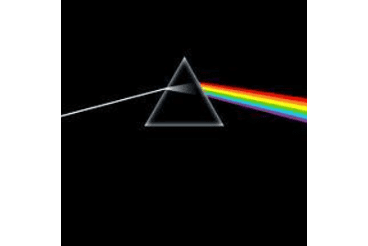
Here’s my innovation: Lessons begin by starting my students' music of choice.
They pick the artists and songs; I teach ’em. We cover all applicable theory as we go, song by song.

Here’s my secret: I teach guitarists of any level how to groove. He/she doesn’t just learn a string of notes and chords; they learn how to play it in tempo and with feeling. I help most students achieve this, fairly fast.
Providing correct charts is one of my specialties. We use charts of every kind – but chart-reading by itself doesn’t make a guitarist…
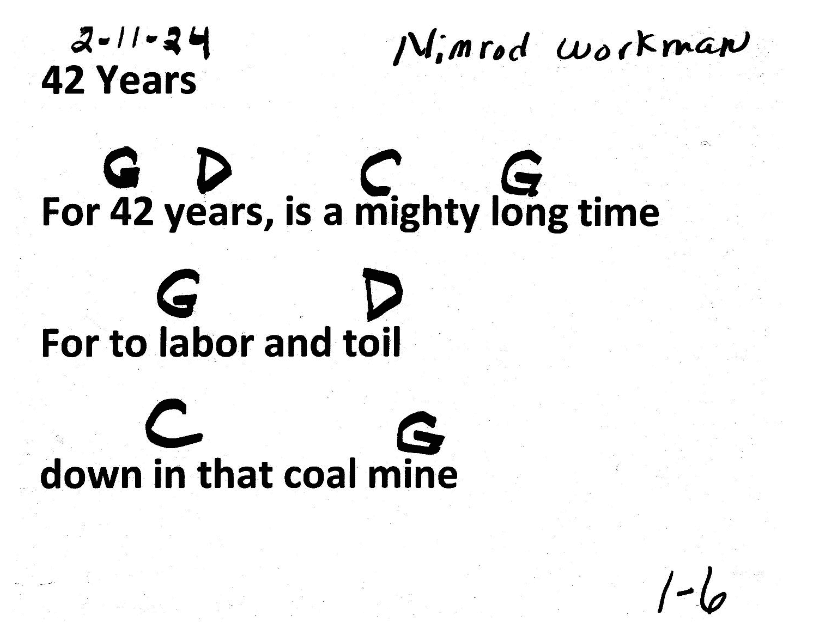
Parts & Charts
Parts is Parts & Charts is Charts:
My students want to learn a song. They may dig for songs from several different artists. With the internet and all its resources, who needs books? A book of charts may cost $40 and have only one of the 10–20 songs that my student wants to learn. Firstly, I can hear the part. Anyone can, with training.
Often, the most effective guitar chart is a Lead Sheet with just lyrics with chords. I make charts, or download one or more of the different chart types that are out there.
I use Word and other methods to create simple Lead Sheets with chords over the words. These are generally the easiest to read while playing guitar and singing.
* * *
Chord Charts
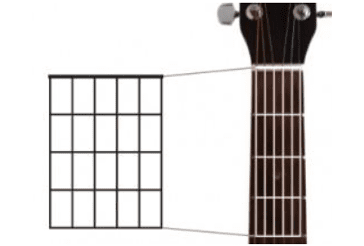
This is a Guitar Chord Chart… It corresponds to this view of the guitar:
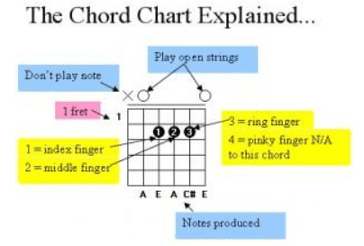
The Chord Chart Explained.

And so here is a guitar chord chart I made.
The “A” chord form shown is of a type that I usually call First chords.
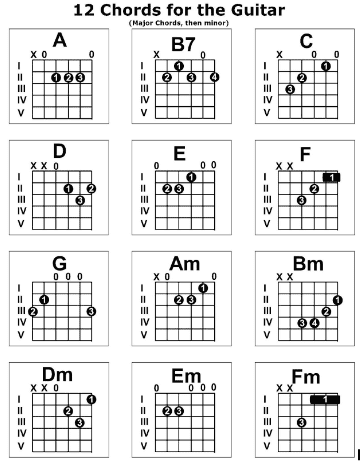
First 12 Chords for Guitar
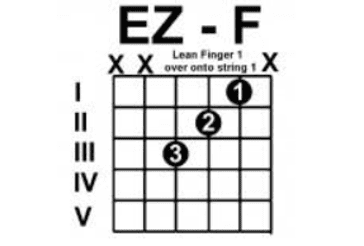
Surprisingly, B7 isn’t as hard to finger on the guitar as it looks; contrary, F is the chord that millions have quit the guitar over. It needn’t be so. Check out EZ-F:
Don’t worry, it’ll sound just fine.
The Musical Alphabet
Chords are named according to the Musical Alphabet, which has only 7 letters,
A-B-C-D-E-F-G
Sing these to the tune of the “Alphabet Song,” but after “G,” sing “A-B-C-D-E-F-G,” again, etc.
It’s a very odd coincidence indeed, that there are seven majorly discernible intervals in both the musical octave, or sound spectrum, and the colors in the visible light spectrum…
It’s like a rainbow!
A tone and a color both repeat every octave at exactly twice the frequency as before.
...and it makes me wonder…

Neck Note Chart
Guitar Neck Notes (or Notes on the Guitar Neck). Here are a couple of charts that I’m pretty proud of it. I’ve searched the world over, but have yet to find a simpler one of its kind, for guitar
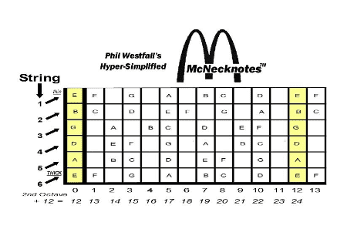
McNecknotes
The simplest guitar neck note chart on earth…
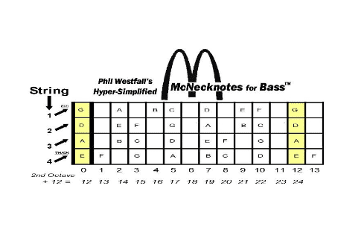
Bass McNecknotes
* * *
Tabs-Chords-Charting
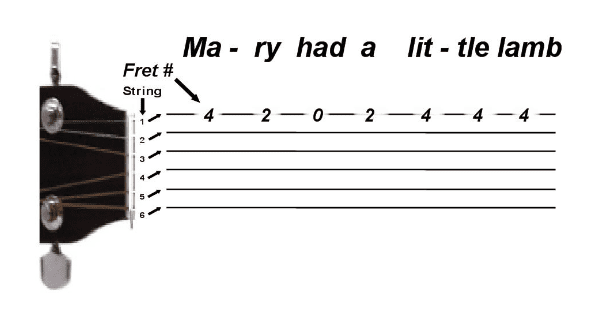
Tablature
Suffice it to say, a “tab” is a picture of the guitar neck, oriented as shown below.
The Tab Explained…
Check out this tab of “Mary Had A Little Lamb” with fret numbers shown on skinny String 1:
Alternative Ways to Chart Guitar Parts…
Yo, dude, if you already know a few chords, what’s wrong with this?
G D Em
I read the news today. Oh boy
(Guitar Chords on Words, or what I call “Lead Sheet” format)
Chord Mapping
4
/ G D / Em / C F / Em /
4
WHERE THERE ARE 4 BEATS PER MEASURE; (4/4 TIME MEANS 4 QUARTER NOTES, OR BEATS to a measure).
Between the bar “/” marks lie 4 beats (one measure). If there’s one chord in there, it gets 4 beats; if there are two chords, they each get 2 beats. There are many variations and elaborations on this simple concept, which I call a Chord Map.
* * *
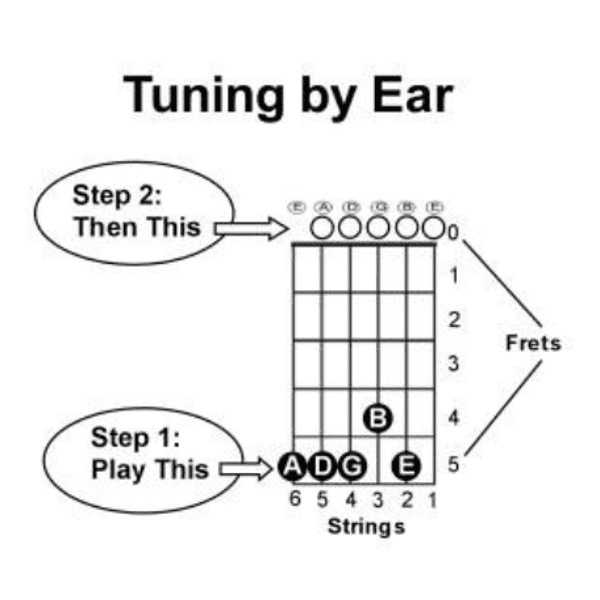
Tuning
The TUNING Thing…
TUNING your guitar can be a huge challenge, especially if you’re playing in a style that calls for being in tune.
But electronic tuners make the job easy.
Phil’s Snark Demo
youtu.be/dxYFmHhoZuQ
Recent metal styles use Drop D, Drop C#, and Drop C a lot. Then there are those 7-String guitars with a low B—five frets lower in pitch than the Standard-Tuned 6th string.
And besides regular E Standard, we often run into Eb Standard and D Standard—I've even seen A Standard—no kidding, I swear. Speakers these days can really handle the low frequencies. The human ear can only make out tones down to about 20 Hz (vibrations per second), but we can feel pitches even lower. Ultra-deep frequencies are felt, rather than heard, and I guess that’s what Bass Drops
www.youtube.com/watch?v=M-n4cWNK2MQ
are all about.
For in-depth info on alternate guitar tunings, you might try going to:
Wikipedia List of Guitar Tunings: en.wikipedia.org/wiki/List_of_guitar_tunings
Tuning By Ear?
Yes, you can tune a guitar by ear. Once upon a time, that was the only way guitarists played. Follow the steps shown above, and any guitar can be put into tune with itself. The trick is deciding which string you consider in tune, and which string you’re matching up to the in-tune string.
CHORDS REALLY SOUND GREAT ON AN IN-TUNE GUITAR!
